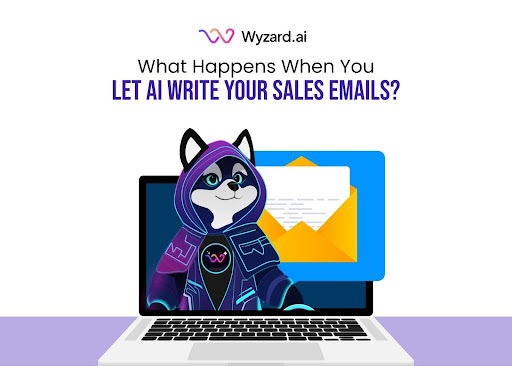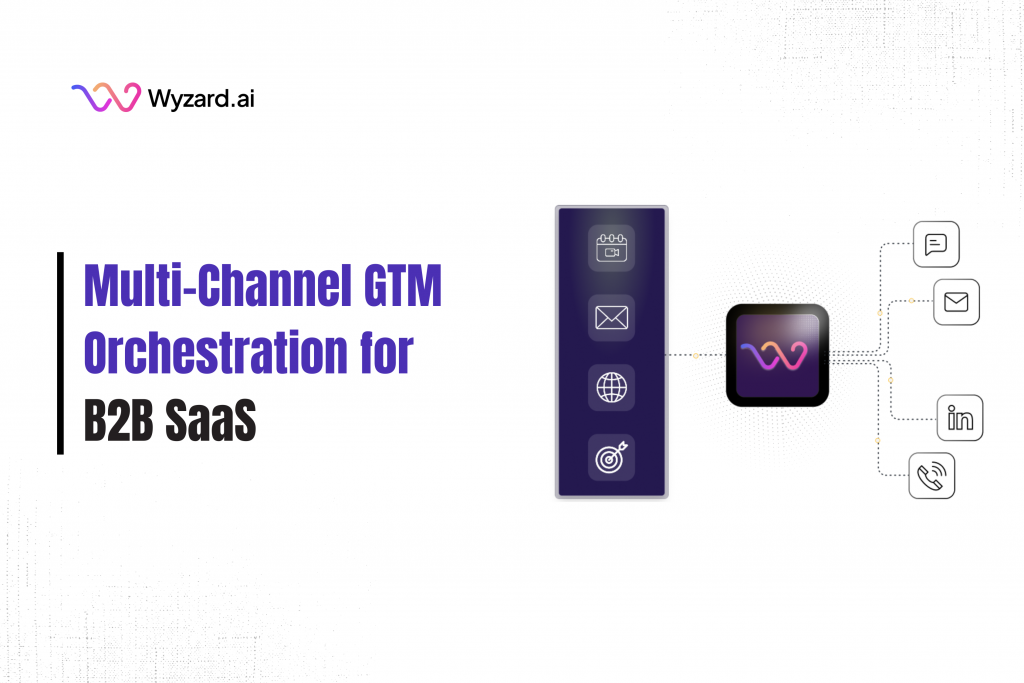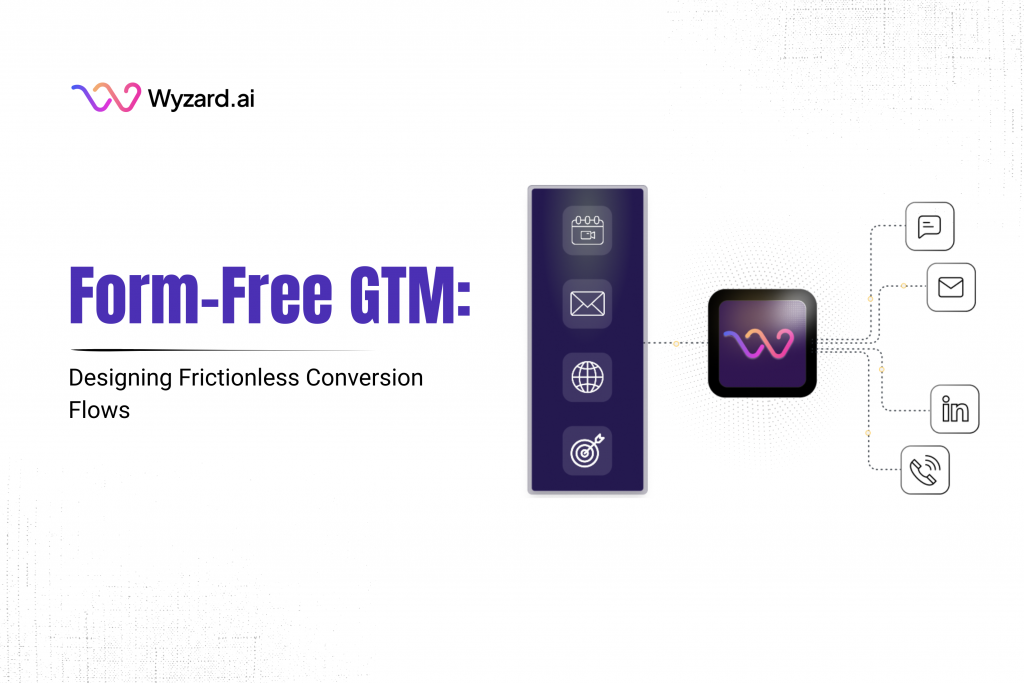If you run marketing or revenue for a B2B SaaS company, the goal is clear: turn GTM spend into ...

Subscribe Now
Your sales team sends hundreds of emails weekly, but response rates keep dropping. You’ve heard about AI email writing tools, but what actually happens when you hand over your outreach to algorithms? The reality is more nuanced than you might expect.
AI sales emails can transform your go-to-market efficiency when done right. But they can also tank your credibility faster than a badly timed cold call. Let’s break down exactly what happens when you let AI handle your sales outreach, backed by real performance data and practical insights for B2B SaaS teams.
What happens when AI writes your sales emails
When you deploy an AI email generator, three immediate changes occur in your sales workflow. First, your email production speed increases dramatically. Sales reps who previously spent 2-3 hours daily crafting personalized messages can now generate initial drafts in minutes. This isn’t just about typing faster; it’s about analyzing prospect data, pulling relevant insights, and structuring messages that match your winning templates.
Second, your personalization scales beyond human capacity. Modern AI for email writing can process thousands of data points from company news and job changes to product usage patterns and engagement history. Where manual personalization stops at first names and company names, AI email writing tools can reference specific pain points, recent company milestones, and relevant use cases without requiring hours of research per prospect.
Third, your consistency improves across the team. Junior reps suddenly write with the precision of your top performers. Brand voice stays intact across campaigns. Common errors, missing links, broken formatting, and off-brand language get caught before sending. The baseline quality of every message lifts, even if the ceiling stays human-controlled.
But here’s what also happens: your emails start sounding similar to everyone else using the same tools. Generic AI-generated messages get flagged by spam filters more frequently. Recipients develop “AI blindness”; they can spot template language and disengage instantly. The emotional nuance that builds real relationships gets lost in data-driven personalization.
Tools like Wyzard, the Signal-to-Revenue-AI address this by connecting buyer signals across your entire tech stack, ensuring AI-powered outreach responds to actual intent rather than generic triggers. When your emails reflect genuine buying moments instead of arbitrary sequences, response rates improve regardless of who or what wrote them.
How AI email writing tools actually perform in sales campaigns
Performance data reveals a split story. Companies using AI sales emails report measurable improvements in efficiency metrics but mixed results on relationship-building outcomes.
AI Email Writing Performance Metrics:
| Metric | Manual Emails | AI-Generated Emails | Improvement |
| Time per email | 8-12 minutes | 2-3 minutes | 70-75% faster |
| Personalization scale | 20-30/day | 200-300/day | 10x capacity |
| Grammar/spelling errors | 3-5% | <1% | 80% reduction |
| Open rates | 18-22% | 27-33% | 50% increase |
| Response rates | 6-8% | 5-12% | Variable |
| Meeting bookings | Baseline | +13-18% | When properly trained |
The variability in response rates tells the real story. Automated email outreach powered by AI performs exceptionally well when:
- The AI tool is trained on your actual winning emails, not generic templates
- Human oversight reviews and refines outputs before sending
- The system integrates with your CRM for accurate, current prospect data
- Messages respond to specific buyer signals rather than blind sequences
It performs poorly when used as a “set and forget” solution. Sales teams that generate thousands of AI cold emails without human review see declining response rates over time. Recipients pattern-match the language and tune out. Spam filters learn to recognize the syntax. Your sender reputation suffers.
The breakthrough comes when AI email writing connects to intent data. Rather than generating emails based on demographic triggers alone, tools that detect actual buying signals, website visits, content downloads, and competitor research can craft outreach that feels relevant because it is. Your AI writes to prospects showing active interest, not cold lists purchased from data vendors.
Why AI sales emails get better open rates than manual emails
The open rate advantage of AI email writing stems from three technical capabilities humans can’t match at scale.
Data-driven send time optimization tops the list. AI analyzes when individual recipients historically open emails, cross-references that with broader engagement patterns, and schedules delivery for maximum visibility. Manual scheduling requires guesswork or sending everything at 9 AM. AI identifies that your prospect opens emails at 6:47 PM on Tuesdays and hits send accordingly.
Subject line testing and optimization happen continuously. While your team might A/B test two subject line variations monthly, AI email generators can test dozens of variations daily, learning which language patterns drive opens for different segments. The system recognizes that technical buyers respond to specific outcome statements while business buyers prefer challenge-focused questions, then adjusts accordingly.
Personalization depth at scale creates subject lines that reference recent company news, mutual connections, or specific product features relevant to each prospect’s role. This level of customization would require hours of research per email manually. AI completes it in seconds, pulling data from multiple sources and synthesizing it into contextually relevant hooks.
However, high open rates mean nothing if the email body fails to convert. This is where AI-powered email management becomes critical. The same intelligence that optimizes open rates should extend through the entire message, maintaining relevance from the subject line through the call-to-action.
Wyzard.ai’s Agentic Email feature addresses this by ensuring every message matches where prospects are in their journey, not just getting them to open, but keeping them engaged through timely, relevant content that advances the conversation naturally.
What response rates can you expect from AI-written sales emails
Response rate expectations vary significantly based on implementation approach and campaign type. Industry benchmarks show:
Cold outreach campaigns: 2-5% response rates for basic AI cold email, rising to 8-12% when AI analyzes prospect behavior and crafts messages around demonstrated intent. The difference comes from relevance: are you emailing someone who visited your pricing page yesterday, or someone whose email you scraped from a directory?
Warm follow-ups: 15-25% response rates when AI references specific previous interactions, content engagement, or mutual connections. These messages benefit from existing context and relationship foundation.
Reactivation campaigns: 5-15% response rates for dormant leads when AI identifies triggering events (funding rounds, executive changes, competitor migrations) that create renewed relevance.
The response quality matters as much as quantity. AI-generated emails that ask vague questions like “Are you interested in learning more?” generate low-quality responses, mostly auto-replies and polite rejections. Messages that reference specific challenges and propose concrete next steps generate higher-intent responses that convert to meetings.
Several factors compound response rates:
- List quality: Fresh, verified contacts respond 3x better than aged data
- Timing: Outreach triggered by buyer signals converts 5x better than arbitrary sequences
- Value proposition clarity: Specific outcomes beat feature lists consistently
- Call-to-action friction: Calendar links outperform “reply to schedule” requests
When integrated with visitor behavior analysis, AI email writing can trigger outreach based on demonstrated interest rather than demographic assumptions. A prospect who visited your pricing page, reviewed three case studies, and downloaded a comparison guide represents a fundamentally different opportunity than a cold contact who matches your ICP criteria. AI that detects these signals and crafts relevant outreach accordingly delivers response rates that manual processes can’t touch.
How to improve AI-generated sales email performance
Improving automated email outreach requires strategic intervention in five key areas:
Train on your winners, not generic templates. Feed your AI email writer examples of emails that actually generated meetings. Include the context, what stage of awareness, which segment, and what triggering event. Generic templates produce generic results. Your best-performing emails contain patterns worth replicating.
Enrich your data foundation. AI email writing quality depends entirely on input data quality. Stale contact information, missing firmographic details, and outdated intent signals produce irrelevant messages regardless of AI sophistication. CRM data enrichment ensures your AI has accurate, current information to personalize effectively.
Implement human-AI collaboration. Top-performing teams use AI email generators for initial drafts, then have reps add specific context before sending. This combines AI efficiency with human judgment. The rep might add a reference to a recent LinkedIn post, adjust tone based on previous interactions, or modify the call-to-action based on deal stage.
Connect AI to real-time signals. Email performance improves dramatically when messages respond to actual buying behavior. Integrate your AI email writing tool with website visitor tracking, content engagement data, and intent signals. When prospects show interest, your outreach should reflect it immediately.
Test systematically. Run controlled experiments comparing AI-generated variants against each other and against human-written control messages. Track beyond open rates, measure response quality, meeting conversion, and pipeline generation. Adjust your AI prompts based on what actually advances deals, not just what generates activity.
Wyzard, the Signal-to-Revenue-AI connects across your marketing and sales tools through native integrations, ensuring AI-powered outreach draws from complete prospect context rather than isolated data silos. When your AI can see website visits, email engagement, and CRM history simultaneously, the resulting messages reflect actual prospect behavior instead of assumptions.
When AI Sales Emails Fail, and What Causes Poor Results
AI email writing fails predictably in specific scenarios. Understanding these failure modes prevents wasted effort and damaged relationships.
Tone-deaf personalization represents the most common failure. AI references information that’s technically accurate but contextually inappropriate, congratulating someone on a company milestone that was actually a layoff announcement, or mentioning a recent job change to someone who was fired. These errors stem from AI analyzing data points without understanding emotional context.
Generic value propositions plague AI cold emails that aren’t trained on specific use cases. The AI generates technically correct but meaningless phrases like “improve efficiency” or “drive growth” without connecting to prospect-specific challenges. Recipients skim these messages and delete them immediately because nothing indicates the sender understands their situation.
Missing the buying stage causes AI-generated follow-ups to feel pushy or premature. A prospect who downloaded a top-of-funnel awareness asset doesn’t want a calendar link and pricing discussion. They need education and trust-building. AI that can’t differentiate awareness-stage prospects from evaluation-stage prospects sends the wrong message at the wrong time.
Overreliance without oversight compounds errors exponentially. One poorly trained AI email writer sending 1,000 messages daily creates 1,000 bad first impressions before anyone notices the problem. Unlike human errors that affect a handful of prospects, AI errors scale instantly.
Data disconnection undermines personalization when the AI can’t access the complete prospect context. If your AI email generator pulls only from your CRM while missing website activity, content engagement, and support interactions, the resulting messages ignore critical context that prospects expect you to know.
AI lead nurturing done well requires connecting signals across all touchpoints. When prospects engage with your brand through multiple channels but your AI only sees email responses, you miss the full picture and send messages that feel disconnected from the actual relationship.
Should you let AI write all your sales emails?
The short answer: No. The practical answer: It depends on the email type and your implementation maturity.
Let AI handle these emails:
- High-volume outreach to early-stage prospects showing buying signals
- Follow-ups referencing specific content downloads or website visits
- Scheduling confirmations and meeting logistics
- Standard responses to common questions
- Reactivation campaigns for dormant leads with new triggering events
Keep humans writing these emails:
- First outreach to strategic accounts
- Messages addressing sensitive topics or concerns
- Negotiations and complex deal discussions
- Relationship-building with executive stakeholders
- Responses to escalations or complaints
The optimal approach combines AI efficiency with human judgment. Use AI for email writing that scales well, initial drafts, data synthesis, and language optimization. Reserve human effort for situations requiring emotional intelligence, strategic thinking, and relationship intuition.
This hybrid model delivers the efficiency gains AI promises while maintaining the authenticity that converts prospects into customers. Your AI email generator becomes a productivity multiplier, not a replacement for sales skills.
Wyzard.ai’s approach reflects this balance; AI detects signals and triggers outreach, but human oversight ensures relevance and appropriateness. When a prospect visits your pricing page at 2 AM, Wyzard.ai can queue a contextual follow-up for morning delivery, draft initial message suggestions based on their browsing pattern, and surface relevant case studies. Your rep reviews, refines, and sends, combining AI speed with human judgment.
FAQs
Can AI email generators write cold emails that actually get responses?
Yes, but response quality depends on implementation. AI cold email tools that connect to buyer intent signals and use your best-performing templates as training data can achieve 8-12% response rates. Generic AI-generated messages without context typically hover around 2-5%.
How much time does AI email writing actually save sales teams?
Sales reps using AI for email writing save 70-75% of their drafting time, reducing 8-12 minutes per email to 2-3 minutes. Teams report saving approximately 12 hours weekly, which they redirect toward relationship-building and deal progression instead of message composition.
Do recipients know when emails are AI-generated?
Recipients often recognize generic AI sales emails through repetitive phrasing and template-like structure. However, when AI email generators are trained on your specific voice and combined with human review, the messages maintain authenticity while scaling personalization that manual processes can’t match.
What’s the biggest mistake teams make with automated email outreach?
The most damaging mistake is deploying AI email writing without human oversight. Teams that generate thousands of messages daily without review create scalable errors, tone-deaf personalization, inappropriate timing, and generic value propositions that damage sender reputation faster than manual mistakes ever could.
Should different sales scenarios use different AI email writing approaches?
Absolutely. High-volume prospect outreach, content follow-ups, and meeting logistics work well with AI automation. Strategic account outreach, sensitive negotiations, and executive relationship-building need human crafting. The best teams use AI email generators for efficiency gains while keeping humans on communications requiring emotional intelligence.
Other blogs
The latest industry news, interviews, technologies, and resources.
Form-Free GTM: Designing Frictionless Conversion Flows
A visitor lands on your pricing page. They are ready to talk, not to wrestle with a 12-field form. ...

December 8, 2025
Outcome-Led Paid Campaigns: Beyond Clicks and CPL
You put serious money into paid media. Dashboards show strong CTR and healthy CPL. The next slide hits and ...

 We’ve secured funding to power Signal-to-Revenue AI to GTM teams globally. →
We’ve secured funding to power Signal-to-Revenue AI to GTM teams globally. →


